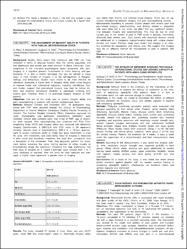| dc.contributor.author | Alikaj, Albina | |
| dc.contributor.author | Büyükaslan, Ayşe | |
| dc.contributor.author | Uğurlu, Serdal | |
| dc.contributor.author | Dilek, Burcu | |
| dc.date.accessioned | 10.07.201910:49:13 | |
| dc.date.accessioned | 2019-07-10T19:50:31Z | |
| dc.date.available | 10.07.201910:49:13 | |
| dc.date.available | 2019-07-10T19:50:31Z | |
| dc.date.issued | 2018 | en_US |
| dc.identifier.citation | Alikaj, A., Büyükaslan, A., Uğurlu, S. ve Dilek, B. (2018). The assessment of imagery ability in patients with familial mediterranean fever. Congress of the European-League-Against-Rheumatism (EULAR) içinde (1852-1852. ss.). Amsterdam, Netherlands, June 13-16, 2018. https://dx.doi.org/10.1136/annrheumdis-2018-eular.5669 | en_US |
| dc.identifier.issn | 0003-4967 | |
| dc.identifier.issn | 1468-2060 | |
| dc.identifier.uri | https://dx.doi.org/10.1136/annrheumdis-2018-eular.5669 | |
| dc.identifier.uri | https://hdl.handle.net/20.500.12511/2006 | |
| dc.description | Congress of the European-League-Against-Rheumatism (EULAR) -- JUN 13-16, 2018 -- Amsterdam, NETHERLANDS | en_US |
| dc.description | WOS: 000444351005543 | en_US |
| dc.description.abstract | Background: Studies have shown that individuals with FMF are more restricted in terms of physical function than the normal population and that depression and anxiety are more common in these individuals. Catastrophizing is the strongest psychological factor associated with pain. Imagery is a cognitive process fundamental to motor learning and performance. It is also a mental technique that can be utilised in many ways. A main function of imagery is to aid self-regulation of thoughts, feelings, and behaviours. Studies have shown to be more effective for individuals displaying a higher level of imagery ability when using imagery to improve motor and motivational outcomes, including self-efficacy. Several studies suggest that pain-related imagery may help to reduce distress and increase behavioural flexibility in individuals suffering from chronic pain. However, there is no published imagery research in FMF patients. Objectives: The aim of this study was to assess imagery ability and pain catastrophizing in patients with familial mediterranean fever. Methods: Between October and December 2017, 30 participants diagnosed with FMF were recruited through the Division of Rheumatology Department of Internal Medicine Cerrahpasa Medical Faculty University of Istanbul. The Istanbul Medipol University Ethics Committee approved the study. Demographic and participant characteristic information were recorded. Clinical data collected were: Age onset of FMF, age of diagnosis were inquired. Pain catastrophizing was assessed with Pain Catastrophizing Scale (PCS) and imagery ability was assessed with Movement Imagery Questionnaire- 3 (MIQ-3).A total PCS score of 30 represents clinically relevant level of catastrophizing. MIQ-3 is a 12-item questionnaire to assess individuals ability to image four basic movements: a knee lift, jump, arm movement, and waist bend. Ease of imaging is measured in both visual and kinesthetic modalities. For each item, participants read a description of the movement. Then, they physically perform the movement before assuming the same starting position to either visually or kinesthetically image the movement. Following this step, participants rate their ease of imaging on a 7-point Likert-type scale ranging from 1 to 7 (very hard/easy to see/feel). After the items for each subscale are averaged, a higher score represents a greater ease of imaging. | en_US |
| dc.description.sponsorship | European League Against Rheumatism | en_US |
| dc.language.iso | eng | en_US |
| dc.publisher | Bmj Publishing Group | en_US |
| dc.rights | info:eu-repo/semantics/openAccess | en_US |
| dc.subject | Patients | en_US |
| dc.subject | Familial | en_US |
| dc.subject | Mediterranean | en_US |
| dc.subject | Fever | en_US |
| dc.title | The assessment of imagery ability in patients with familial mediterranean fever | en_US |
| dc.type | conferenceObject | en_US |
| dc.relation.ispartof | Congress of the European-League-Against-Rheumatism (EULAR) | en_US |
| dc.department | İstanbul Medipol Üniversitesi, Sağlık Bilimleri Fakültesi, Fizyoterapi ve Rehabilitasyon Bölümü | en_US |
| dc.authorid | 0000-0002-4532-9956 | en_US |
| dc.authorid | 0000-0002-4169-6302 | en_US |
| dc.identifier.volume | 77 | en_US |
| dc.identifier.issue | Supplement: 2 | en_US |
| dc.identifier.startpage | 1852 | en_US |
| dc.identifier.endpage | 1852 | en_US |
| dc.relation.publicationcategory | Konferans Öğesi - Uluslararası - Kurum Öğretim Elemanı | en_US |
| dc.identifier.doi | 10.1136/annrheumdis-2018-eular.5669 | en_US |
| dc.identifier.wosquality | Q1 | en_US |


















